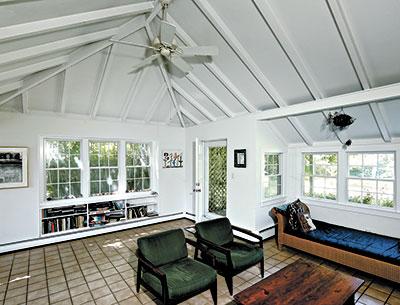Alfred Scheffer: Postwar Pioneer

“Since the 1950s, American families have gotten smaller while homes have nearly doubled in size.” —Yale University Architectural Team
With no apparent slowdown in the making of megamansions, a book has just come out that tempts us back to the days when small really was beautiful. It is “Alfred A. Scheffer’s Beach Hampton Houses, 1941 to 1965,” written by Robert Hefner, the East Hampton Village director of historic services.
The prose and photographs document the small-scale, refined adaptations of Cape Cod-style architecture that were produced by someone known as the dean of East Hampton architects, who died in 1976. In an era of small houses, Schef, as he was called, showed how cozy can be luxury enough and summer extravagance can be just living, pool-less, within walking distance of blue water and white sand.
An architecture graduate of the University of Pennsylvania, Scheffer first practiced in New York City, designing Tudor and Georgian houses in Westchester County and the UpIsland suburb of Douglaston. At the Barbour restaurant, close to his office at 54th Street and Fifth Avenue, he became friendly with the owner, Ella Barbour. She and her husband, a bond trader, had gotten interested in “Beach Hampton,” which was envisioned by the New York City developer R. B. Allen as a community of modest summer cottages in the Amagansett dunes.
For middle-class people “a weekend vacation house in the Hamptons was a new concept, made possible by the state parkways built by Robert Moses in the 1930s,” Mr. Hefner writes.
By the late ’30s, Mr. Allen had assembled more than 200 acres between the ocean beach and Bluff Road and the Montauk Highway, bounded west and east by Beach and Napeague Lanes. Mrs. Barbour soon bought land for a beach club, creating, Mr. Hefner says, “the first Manhattan restaurant to open a branch in the Hamptons.”
Its modest building, which Scheffer designed with his then-partner Lester Tichy, was “one of the earliest modernist buildings on Long Island,” but it was lost at the end of its first season when the 1938 Hurricane poured water over the dunes as far up as Route 27.
With typical Hamptonesque optimism in the face of near-certain future hurricanes, Mrs. Barbour and Mr. Allen each commissioned Scheffer houses. He eventually designed 15 for Mrs. Barbour and her children, four in Beach Hampton and others in the New York suburbs. Eventually the Barbours encouraged Scheffer to build a house for himself near theirs. He also designed three model houses of from 560 to 920 square feet for Mr. Allen, and about 25 Beach Hampton structures in all. Often built on no more foundation than concrete slabs, some of the houses were started in April and habitable by Memorial Day.
All were nuanced. Mr. Hefner expertly identifies “well-studied proportions” with no applied ornament save decorative shutters, low, “ground-hugging” designs to fit into the dune landscape, and outstretching, shaded terraces. Though the exteriors were traditional, the interiors show how Scheffer “treated a traditional form with a modem aesthetic.”
The houses often included expansive two-story cathedral living rooms with exposed beams, large fireplaces, and walls of unpainted, weathered brick or knotty pine. The layouts were informal, with dining areas instead of dining rooms and small bedrooms. Scheffer “created a refined interior by giving much attention to subtle details” like the proportions of the rooms, simple fireplace mantels, and built-in bookcases.
The book, with historic photos, new ones by Jeff Heatley, and research by John Gibson, was commissioned by Greg Zwirko, Scheffer’s nephew, who spent summers at the Scheffer house in Amagansett and was Scheffer’s “apprentice” for seven years until the architect’s death. He continues the practice as Zwirko and Ortmann Architects.
Copies of the book are available for $71.70; an e-book version is $9.99. Links to both are at www.alfredascheffer.com. BookHampton is expected to have copies around March 1.
All but a handful of Scheffer’s Beach Hampton houses have been torn down or modified, but a number are still intact, including three built between 1959 and 1965 on Sandpiper Lane. As the postwar economy improved, Scheffer started doing larger houses in the Hamptons. They warrant a book of their own before they, too, are demolished. Altogether, Scheffer built some 200 houses on Long Island. But the Beach Hampton ones, Mr. Hefner shows, reveal the essence of a master.
